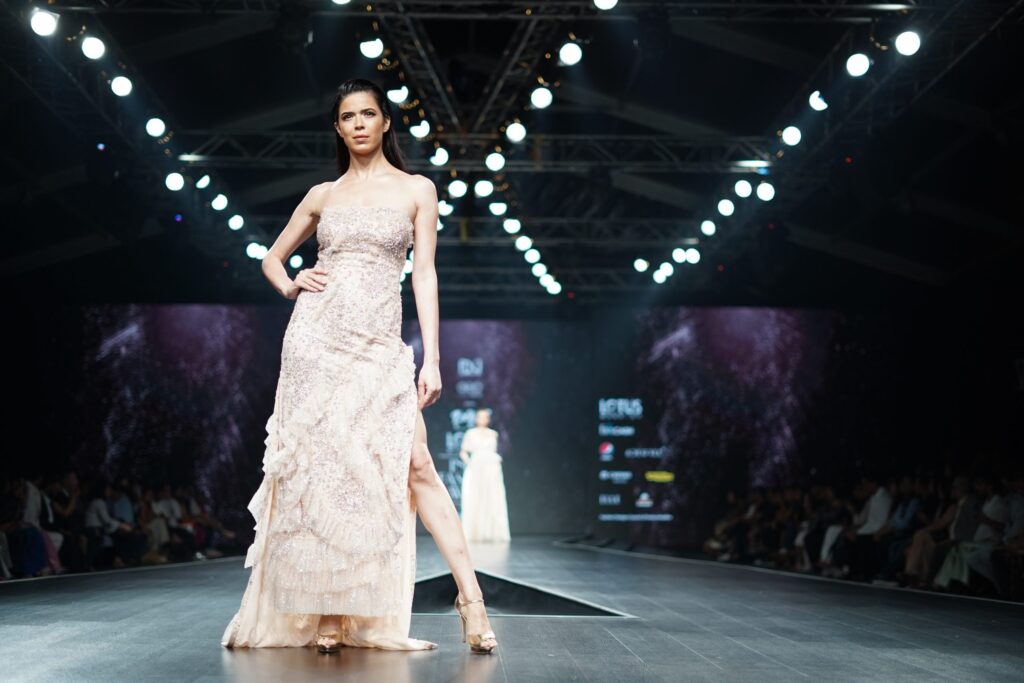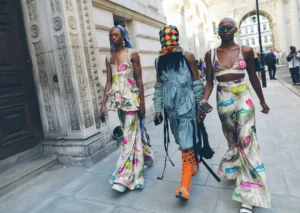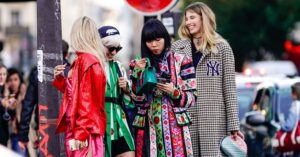Hey there, picture this: It’s 1858 in Paris, and a clever Englishman named Charles Frederick Worth is flipping the script on how the elite get dressed. No more anonymous seamstresses stitching away in the shadows—he’s slapping his name on every gown, turning clothing into a branded spectacle. That moment? It’s the spark that ignited high fashion as we know it. Fast-forward to today, where runways blend ancient craftsmanship with AI-driven designs, and you’ve got a story that’s equal parts glamour, grit, and global shake-up. I’ve spent years chasing this rabbit hole, from dusty archives in Florence to front-row seats at Milan shows, and let me tell you, the evolution of high fashion isn’t just about hemlines rising or falling. It’s a mirror to our wildest societal shifts, and it’s got me hooked every time.
The Dawn of Haute Couture: From Tailors to Titans
High fashion didn’t burst onto the scene fully formed; it simmered in the salons of 19th-century Europe, where industrial hums met royal whims. Charles Worth, often dubbed the father of haute couture, catered to Empress Eugénie of France, dressing her in silks that whispered power. His House of Worth wasn’t just a workshop—it was a theater, complete with mood boards and model presentations that made shopping feel like attending a play.
This era marked the birth of “high sewing,” or haute couture, where garments were bespoke masterpieces, hand-stitched for the ultra-wealthy. Think corseted bodices cinching waists to impossible measures, all while skirts ballooned with crinolines that could double as life rafts. It was extravagant, exclusionary, and utterly addictive. I remember thumbing through a faded Worth sketchbook in a London museum, feeling that electric buzz of innovation—clothing as art, not utility.
Key Figures Who Shaped the Foundations
Worth wasn’t alone; a cadre of visionaries built this gilded empire. Jeanne Lanvin started with hats for her daughter, evolving into ethereal gowns that caught royalty’s eye by the 1910s. Paul Poiret, the “King of Fashion,” ditched corsets for harem pants in 1911, scandalizing Paris but freeing women’s silhouettes.
These pioneers turned fashion into a spectator sport, with salons buzzing like modern-day influencers’ feeds. Their legacy? Proving that a single seam could upend social norms, one daring design at a time.
Roaring Twenties to Wartime Realities: Liberation and Rationing
The 1920s crashed in like a champagne cork, popping the bubble of Victorian restraint. Flappers in beaded fringe and bobbed hair danced the Charleston, their dropped-waist dresses screaming independence post-suffrage. Coco Chanel, that sly genius, swapped fussy lace for jersey knits and little black dresses—practical yet chic, like the ultimate wardrobe multitasker.
War flipped the script again. World War II rationed fabric, birthing utilitarian chic: square shoulders on suits for women entering factories, hemlines hiked to save material. It was high fashion’s grit test—glamour forged in scarcity. I once interviewed a 90-something seamstress who mended blackout curtains by day and dreamed up bias-cut gowns by night; her stories remind me how resilience stitches us into history’s fabric.
Iconic Shifts in Silhouettes and Fabrics
Synthetic innovations like rayon emerged, democratizing luxury without the silk price tag. Gabrielle “Coco” Chanel’s No. 5 perfume in 1921 wasn’t just scent—it was high fashion’s first olfactory runway hit.
These changes weren’t mere trends; they were battle cries for equality, proving fashion could flex with the times—or get left in the trenches.
Post-War Boom: Dior’s New Look and the Golden Age
Nothing says “peace at last” like yards of taffeta swirling around ankles. Christian Dior’s 1947 “New Look” debuted with full skirts and nipped waists, a defiant middle finger to wartime austerity. Paris reclaimed its throne, with houses like Balenciaga crafting sculptural coats that turned wearers into walking architecture.
This golden era birthed the ready-to-wear revolution, blending couture precision with mass appeal. Audrey Hepburn in Breakfast at Tiffany’s made shift dresses eternal, while Hollywood exported glamour worldwide. It’s the era that makes me misty-eyed—my grandmother’s yellowed photos show her in a Dior-inspired frock, twirling at a victory ball, whispering of hope reborn.
The Rise of Fashion Capitals Beyond Paris
London and New York muscled in, with Savile Row suits and American sportswear challenging French dominance. Yves Saint Laurent’s 1966 “Le Smoking” tux for women blurred gender lines, a cheeky nod to evolving identities.
These hubs weren’t just geographic; they were cultural crossroads, where high fashion started speaking every language.
Swinging Sixties to Punk Rebellion: Youthquake Upends the Elite
The ’60s hit like a mini-skirt whirlwind—Mary Quant shortened hems to mid-thigh, sparking moral panics and mod mania. Psychedelic prints and space-age plastics from André Courrèges screamed futurism, while London’s Carnaby Street became the anti-couture epicenter.
Punk crashed the party in the ’70s, with Vivienne Westwood’s safety-pin aesthetics ripping high fashion’s velvet ropes. It was raw, rebellious, and hilariously subversive—think Sid Vicious in a ripped tee that cost more than a suit. I laughed out loud at a Westwood exhibit last year, spotting a gown safety-pinned from trash bags; it’s proof that revolution wears what it wants, consequences be damned.
Subcultures That Infiltrated the Runways
Hippie communes birthed kaftans and tie-dye, filtering into Halston’s fluid eveningwear. Disco’s sequins and platforms? Yves Saint Laurent’s Studio 54 soirées made them couture staples.
These grassroots uprisings didn’t just influence—they hijacked high fashion, turning street grit into gold.
The ’80s Power Play and ’90s Minimalist Backlash
Excess defined the ’80s: shoulder pads wide as goalposts, neon hues clashing like corporate takeovers. Giorgio Armani’s unstructured suits empowered Wall Street women, while Jean-Paul Gaultier’s cone bras turned Madonna into a walking manifesto.
The ’90s recoiled with grunge and minimalism—Calvin Klein’s stark whites and Kate Moss’s waifish “heroin chic” stripped away the glitz. It felt like fashion’s therapy session, purging ’80s indulgence. Personally, this decade hits home; I thrift-shopped my first “designer” slip dress in ’95, feeling like a minimalist queen amid the flannel frenzy.
Globalization’s Grip on High Fashion
Supply chains stretched to Asia, fast fashion like Zara aping runways in weeks. Versace’s baroque opulence met Gap’s basics, blurring luxury lines.
This mash-up accelerated trends but sowed ethical seeds—cheap chic at what hidden cost?
Digital Dawn and Sustainable Shifts: 2000s to Now
The 2000s obsessed over logos—low-rise jeans and Juicy Couture tracksuits screamed status. Reality TV birthed celeb designers like Jessica Simpson’s line, while blogs democratized critique.
Today, high fashion grapples with climate reckoning. Stella McCartney’s vegan leathers and Gabriela Hearst’s upcycled silks lead the charge, with the Fashion Revolution movement (sparked by 2013’s Rana Plaza tragedy) demanding transparency. It’s emotional—watching brands pivot from profit to planet feels like growth we all need. Last Earth Day, I audited my closet, ditching fast-fash for heirlooms; it’s small, but it stitches me into the fix.
Tech’s Transformative Touch
3D printing crafts impossible shapes, NFTs digitize couture ownership. Balenciaga’s video game show? Pure 2025 wizardry.
Yet, amid the pixels, handcraft endures—high fashion’s soul in a swipe-right world.
Haute Couture vs. Ready-to-Wear: A Timeless Tussle
Ever wonder why some frocks cost a fortune while others rack up in stores? Haute couture is bespoke artistry—custom fits, rare fabrics, ateliers of wizards sewing by candlelight (okay, LED now). Ready-to-wear (prêt-à-porter) scales that magic for the masses, pioneered by Claire McCardell’s ’40s separates.
Pros and Cons of Each Approach
- Haute Couture Pros: Unmatched quality, emotional investment—like wearing a love letter. Cons: Eye-watering prices (a Dior gown? $50K+), limited access.
- Ready-to-Wear Pros: Affordable entry to trends, versatile sizing. Cons: Less personalization, faster obsolescence.
| Aspect | Haute Couture | Ready-to-Wear |
|---|---|---|
| Customization | Fully bespoke to body | Standard sizes, minor alters |
| Production Time | Weeks to months | Mass-produced, immediate |
| Price Range | $10,000–$100,000+ | $100–$2,000 |
| Sustainability | Often ethical, low-volume | Higher waste, but innovating |
| Iconic Example | Chanel tweed jacket | Levi’s 501 jeans |
This duel keeps high fashion dynamic—elitist dreams fueling everyday dreams.
Iconic Designers Who Redefined the Game
High fashion’s pantheon reads like a who’s who of rebels. Christian Dior’s hourglass revived femininity; Vivienne Westwood’s anarchy punked the establishment. Alexander McQueen’s dark theatrics, like his 1999 No. 13 show, blended sorrow and spectacle—his passing in 2010 left a void, but his spirit haunts every dramatic hem.
Lasting Legacies in Modern Collections
Yves Saint Laurent’s gender-fluid tuxedos echo in today’s androgynous lines; Karl Lagerfeld’s Chanel reinventions prove reinvention is eternal.
These trailblazers didn’t just design—they dared us to evolve.
Where to Source Vintage High Fashion Treasures
Hunting high fashion relics? Start with 1stDibs for authenticated ’50s Dior, or eBay’s vintage auctions for steals under $500. LA’s Rose Bowl Flea Market yields ’80s shoulder-pad gold; for global gems, The RealReal curates pre-loved Prada.
Pro tip: Verify authenticity via hallmarks—Chanel’s interlocking Cs never lie. It’s like time travel, one thread at a time.
Best Tools for Aspiring High Fashion Enthusiasts
Dipping into design? Sketch with Adobe Fresco for digital draping; study via Fashionary sketchbooks. For trend tracking, Vogue Runway’s archives are gold.
- Bullet-point must-haves: Pattern-making software like Clo3D; fabric swatch apps like Calico Fabrics; AR try-on tools from Snapchat Lens Studio.
These gadgets bridge old-world craft with new-world speed.
People Also Ask: Unpacking High Fashion Curiosities
Google’s “People Also Ask” bubbles up the quirky queries that keep fashion historians up at night. Here’s a dive into real ones, pulled from searches on the evolution of high fashion.
Why Did Fashions Change Over Time?
Fashions evolve because society does—wars ration hems, booms balloon them. Post-WWI, women’s suffrage shortened skirts as symbols of freedom; the ’80s power suits mirrored boardroom battles. It’s culture’s pulse, beating through cloth.
What Is Haute Couture Exactly?
Haute couture means “high sewing”—custom, handcrafted luxury using premium materials, regulated by Paris’s Chambre Syndicale. Only 15-20 houses qualify yearly, like Dior or Schiaparelli. It’s not fast fashion; it’s forever heirlooms.
How Did High Fashion Become a Global Business?
Industrial Revolution mechanized production, but Worth’s 1860s shows globalized it—buyers copied Paris for New York shelves. Post-WWII, American ready-to-wear boomed; now, China’s manufacturing muscle and Instagram’s reach make it a $2.5T behemoth.
When Did Street Style Influence High Fashion?
The ’60s Youthquake fused mod streets with runways; ’70s punk ripped couture norms. Today, TikTok scouts dictate trends—Virgil Abloh’s Off-White street-couture hybrid proved the runway now bows to the sidewalk.
FAQ: Your Burning Questions on High Fashion’s Arc
Got queries? These real-user faves from forums and searches get the straight dope.
Q: Who invented the little black dress?
A: Coco Chanel, 1926—timeless, versatile, and born from widow’s weeds reimagined as chic. It’s the high fashion equivalent of jeans.
Q: How sustainable is modern high fashion?
A: Improving, but spotty—Stella McCartney’s zero-waste ethos shines, while others lag. Look for certifications like GOTS for organic bliss.
Q: What’s the most expensive high fashion piece ever?
A: A 2013 Versace gown at $1.2M, dripping in gems. But value’s subjective—McQueen’s emotional artistry trumps bling.
Q: Can anyone start a high fashion line today?
A: Absolutely, with platforms like Etsy for prototypes. Study via Parsons online courses; hustle beats pedigree.
Q: Why do high fashion trends cycle back?
A: Nostalgia meets relevance—’90s minimalism revives in stressed times. It’s fashion’s way of saying, “We’ve been here before, wiser now.”
Whew, what a ride—from Worth’s labels to web3 wardrobes. High fashion’s revolution isn’t over; it’s just logging in. What’s your favorite era? Drop a comment—let’s stitch this conversation onward.




